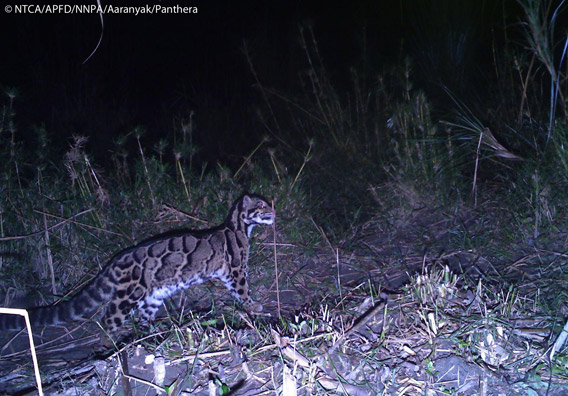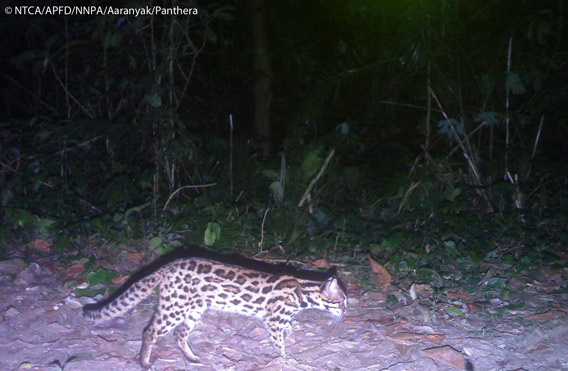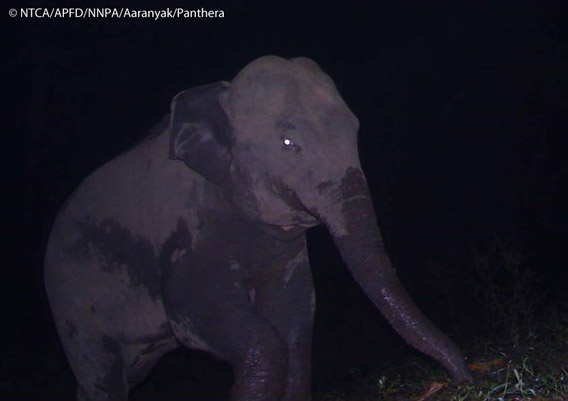Researchers working with local communities in effort to stymie environmental damage
Namdapha National Park, the third largest in India at 200,000 hectares, is located in the northeastern state of Arunachal Pradesh. Its extensive dipterocarp forests are the northernmost lowland tropical rainforests in the world. Temperate broad-leaved forests cloak the higher elevations, and beyond the treeline lie alpine meadows and snow-capped peaks that reach 4,571 meters (14,997 feet). However, the region has lost thousands of hectares of forest in the past decade, and studies project the situation may simply worsen in the coming years.
Namdapha, being part of the Indo-Myanmar biodiversity hotspot, is supposedly the only park in the world to harbor four species of large cats — tigers (Panthera tigris), snow leopards (Panthera uncia, of which there is only one record), clouded leopards (Neofelis nebulosa), and leopards (Panthera pardus). In addition, these forests host India’s only ape, the hoolock gibbon (Hylobates hoolock), and a range of ungulates from montane species such as red goral (Nemorhaedus baileyi) and takin (Budorcas taxicolor) to hog deer (Axis porcinus) in the river valleys.

Clouded leopard in Namdapha. The clouded leopard is listed as Vulnerable by the IUCN Red List. Photo © Panthera, NTCA, APFD, NNPA, and Aaranyak.
However, all this richness looks good only on paper, with any large mammal remarkably hard to come by in the forest.
A study published in Biological Conservation in 2008 revealed the terrible wildlife situation. During the three-month camera trap study, which captured more than 1,500 days of footage, a research team led by Aparajita Datta of the Nature Conservation Foundation in collaboration with various institutions did not detect any tigers or leopards. Large herbivores such as sambar (Rusa uniclor), gaur (Bos frontalis), and serow (Nemorhaedus sumatraensis) were also uncommon. With the exception of Indian muntjac (Muntiacus muntjak), other species were in far lower numbers than similar forests in Southeast Asia.
In subsequent transect surveys conducted between 2008 and 2012, Datta and Rohit Naniwadekar recorded only 29 sightings of the four ungulate species even though they walked 842 kilometers (523 miles). In contrast, in a better protected reserve like Pakke Tiger Reserve in western Arunachal, they had 141 ungulate sightings in 453 kilometers (281 miles) (unpublished data).
However, wildlife numbers weren’t always so dismal. The 2008 study notes anecdotal information indicating healthy populations of tigers and elephants until the early 1990s.
Paradoxically, Namdapha has a remarkable diversity of other wildlife. Biologists have found species that were unknown to occur in India. These not only include large mammals such as the leaf deer (Muntiacus putaoensis) and a dark muntjac (Muntiacus crinifrons/M. gongshanensis), but also cryptic reptiles such as Venning’s keelback (Amphiesma venningi) and Medo pitviper (Viridovipera medoensis). The park clearly is an important wildlife and ecological zone.
For many indigenous tribes living around the park, hunting is a way of life. They hunt for the pot, as a means of recreation and ritual, a source of medicine and ornaments, and to augment incomes.

Male Bengal tiger caught on camera trap in Namdapha Tiger Reserve. Photo © Panthera, NTCA, APFD, NNPA, and Aaranyak.
At 17 people per 100 hectares (Census of India 2011), Arunachal Pradesh has the lowest human population density in India, which has a national average densiy of 365 people per 100 hectares. But the state’s population grew by 26 percent in the decade 2001-2011, when the country’s average growth was only 18 percent. Besides intensive hunting of birds and animals of all sizes by a growing population, rising deforestation compounds the problems of Namdapha.
The Chakma and Miji Mishmi communities living along the park’s western boundary hunt, fish, and harvest firewood and minor forest produce from within the park. Some Chakma settlements line the road from M’pen, the park’s entrance, to Deban. But the community that affects the park the most is the 3,000-strong Lisu community. They inhabit a piece of land between the park and the international boundary with Myanmar. This is arguably the most remote and least developed corner of India.
The River Noa-Dihing, a tributary of the Brahmaputra, severely eroded arable land, and the remaining land is inadequate for a growing population. Left with no choice, families moved into the park, some right into the core area. From 65 families in 2004-05, the number increased to nearly 160 in 2012-13.
According to data from Global Forest Watch, approximately 100,000 hectares of forest were lost from Arunachal Pradesh from 2001-2013, representing more than one percent of the state’s entire area. Namdapha is a part of Changlang district within Arunachal Pradesh, which has experienced an even greater rate of forest cover loss at about 2.5 percent. It’s small comfort that most of the loss has so far outside the park. Unless the status quo undergoes a dramatic change for the better, the protected forest may not be immune from deforestation pressures.

Changlang district (highlighted), in which Namdapha National Park resides, has lost approximately 2.5 percent of its forest cover since 2001. Courtesy of Global Forest Watch.Click to enlarge.
An assessment of the forest cover of Arunachal Pradesh published in Conservation Biology in 2001 noted that 70 percent of the state was forested in 1988. By computing projected population growth and its resultant resource extraction pressures, the study estimated 50 percent of the state’s forests would be lost by 2021. It also predicted that the Namdapha and its surrounding landscape would be almost completely deforested by then.
A report published in Current Science in 2004 estimated 170 hectares (0.7 square miles) of forest, not including swidden areas and settlements, were cleared in five years. It also estimated that the Chakma and Lama from six villages extract 2,790 tonnes (6 million pounds) (dry weight) of forest products from the park annually. Two Lisu settlements inside the park extract about 430 tonnes (948,000 pounds) per year. In 2005, Datta estimated 2,030 hectares (7.8 square miles) of forest were degraded or cleared for settlement development, cultivation, and other uses (unpublished data).
Life for the Lisu is not easy. The Indian government views them as recent migrants from Myanmar, although their villages have existed in the vicinity of Namdapha since at least the 1940s. Till the early 1970s, they enjoyed tribal rights granted to other tribes in the state. But the government revoked their tribal status as well as citizenship in 1979 for reasons that remain unclear. The authorities restored citizenship and voting rights in 1995, but not tribal status that would allow the community members to avail of various benefits like access to hostels for students studying in distant towns and job opportunities in the government.

Namdapha National Park in Arunachal Pradash, India. Photo by Rohit Naniwadekar.
Malaria is a scourge, sometimes wiping out entire families. To seek medical help, the Lisu have to walk or be carried for seven days through the national park. During the monsoon, even this access is sometimes impossible to negotiate. For a long time, vehicles could not ply the 157-kilometer (97.5-mile) road connecting Lisu settlements on the far side of Namdapha to Miao, on the western border of the park, as the jungle had reclaimed it. Groceries and essential supplies are physically carried or occasionally hauled in on the backs of elephants. In 2011, the government began re-building the road but most of its length continues to be impassable for vehicles.
The Lisu’s biggest grievance is the establishment of the national park. Some claim the community owns most of it, and as stakeholders, they feel they ought to have been consulted before the park was created. Like many people living around protected areas in India and elsewhere, they don’t understand the need for the park, and this lack of understanding and empowerment has led to dissatisfaction.
In an effort to rid the park of encroachments, the department destroyed Lisu settlements in the 1980s. If park officials found any Lisu with wild meat or fish in his possession, they confiscated all his belongings. The Lisu burnt forest camps and killed animals in retaliation.

Leopard cat in Namdapha. The leopard cat is listed as Least Concern. Photo © Panthera, NTCA, APFD, NNPA, and Aaranyak.
In 2003, Aparajita Datta of the Nature Conservation Foundation realized that the atmosphere wasn’t conducive for conservation. With support from other institutions, she facilitated the setting up of kindergarten schools in Lisu villages inside and outside the park as well as a health care program that also provided essential medicines for eight years. Other efforts included building embankments to prevent further erosion of arable land, setting up solar energy for lighting and heating, and generating alternative sources of income through pig rearing, handicrafts, tourism, and horticulture.
Several Lisu carried out wildlife surveys as well as monitored hunting activities within the park. Datta conducted conservation education and outreach programs. She hoped that by receiving tangible benefits and recognizing the value of wild fauna, the community would appreciate the park and cooperate in protecting it. Initial indications suggested these efforts made a difference to the Lisu’s quality of life, and they pledged to stop hunting.
In 2005, Datta initiated discussions with different levels of the government to resolve the land issue. She tried to change the government’s perception of the Lisu as poachers, bring recognition to their jungle skills and knowledge of the park, and suggested they become formally involved in the park’s protection.

Asian elephant in Namdapha. The Asian elephant is listed as Endangered by the IUCN Red List. Photo © Panthera, NTCA, APFD, NNPA, and Aaranyak.
Between 2010 and 2012, the district authorities and the Forest Department held a series of meetings with the Lisu. With the help of other tribes resident in that area, they had identified 200 hectares of land near the western side of the park as a possible site of relocation. However, the Lisu turned down the offer as they claimed the land wasn’t good for farming. They also felt staying in the park would be better in the long run, since the need for more land may arise in the future. While Datta had hoped for reconciliation and a negotiated settlement, the Lisu felt that she had taken sides with the government and the long-term relationship ended. This is a big loss for area conservation.
Still, there may be a sliver of hope for Namdapha and its wildlife. In 2012, conservation organizations Aaranyak and Panthera, in collaboration with the Forest Department, obtained a camera-trap photograph of a tiger and other large carnivores, indicating the continued presence of large animals in the park. However, poachers shot at the researchers and the camera traps were stolen.
If the situation remains unchanged, will Namdapha fulfill its scientific prophesy of near total deforestation in another seven years?
Citations:
- Datta, A. 2007. Threatened Forests, Forgotten People. In Making Conservation Work (eds. Shahabuddin G., and M. Rangarajan), pp. 165-209. New Delhi, India: Permanent Black.
Related articles
Next big idea in forest conservation: Reconnecting faith and forests

(07/24/2014) ‘In Africa, you can come across Kaya forests of coastal Kenya, customary forests in Uganda, sacred forest groves in Benin, dragon forests in The Gambia or church forests in Ethiopia…You can also come across similar forest patches in South and Southeast Asia including numerous sacred groves in India well-known for their role in conservation of biological diversity,’ Dr. Shonil Bhagwat told mongabay.com.
On track to ‘go beyond the critical point’: Sri Lanka still losing forests at rapid clip

(07/15/2014) During the latter half of Sri Lanka’s civl war, between 1990 and 2005, Sri Lanka suffered one of the highest rates of deforestation in the world, losing about 35 percent of its old growth forest and almost 18 percent of its total forest cover. The conflict ended in 2009, and while deforestation has slowed somewhat, Sri Lanka is still losing forest cover at a fast pace.
An end to India’s ‘Wild West’? Meghalaya bans coal mining… for now

(07/08/2014) Meghalaya, a state in India’s northeast, has thick forests above ground and valuable minerals below. Uncontrolled mining in the area has cleared forests, degraded rivers, and led to many accidents and deaths as few health and safety standards exist for mine workers. A ban effected earlier this year halted all mining in the state, but is set to be reconsidered at a hearing scheduled for August.
Next big idea in forest conservation? Playing games to understand what drives deforestation

(06/26/2014) Dr. Claude Garcia plays games, but you won’t find him betting his shirt at the casino. As leader of the Forest Management and Development Research Group at ETH Zürich, Garcia and his team use participatory modeling and role-playing games, merged with more traditional disciplinary sciences such as ecology, economics, and sociology to understand and manage complex landscape change in the tropics.
Despite poaching, Indian rhino population jumps by 27 percent in eight years
(06/10/2014) The world’s stronghold for Indian rhinos—the state of Assam—has seen its population leap by 27 percent since 2006, despite a worsening epidemic of poaching that has also seen 156 rhinos killed during the same period. According to a new white paper, the population of Indian rhinos in Assam hit 2,544 this year.
Dancing frogs: scientists discover 14 new species in India (PHOTOS, VIDEO)

(05/16/2014) Scientists have discovered 14 new species of frogs in the mountainous tropical forests of India’s Western Ghats, all of which are described in a recent study published in the Ceylon Journal of Science. The new species are all from a single genus, and are collectively referred to as “dancing frogs” due to the unusual courtship behavior of the males.
‘Simmering conflict’: the delicate balancing act of protecting India’s wilderness

(05/13/2014) The Western Ghats of southern India, one of the world’s top biodiversity hotspots, is a 1600-kilometer (1000-mile) mountain chain that runs parallel to the western coast of the Indian subcontinent. It traverses six states and is home to as many as 250 million people. In an interview with mongabay.com, M.D. Madhusudan of the Nature Conservation Foundation discusses the importance and challenges of establishing protected areas in India.
Scientists release odd-looking, Critically Endangered crocodiles back into the wild (PHOTOS)

(05/13/2014) Among the largest and most endangered crocodilians in the world, the gharial is on the verge of extinction today. This harmless fish-eating crocodile has fewer than 200 adult breeding individuals in the wild, their numbers having plummeted rapidly over the past few decades. But among this gloom and doom, conservationists have been working tirelessly to reinstate the wild populations.
India, not China, has the world’s worst urban air pollution
(05/12/2014) Breathing in urban India is hard: of the world’s top twenty cities with the worst air, 13 of them are found in India, according to a new analysis by the World Health Organization (WHO). Despite the attention recently given to Chinese cities for atrocious air pollution, many of India’s cities are actually worse when comparing annual averages of fine airborne particulates.













